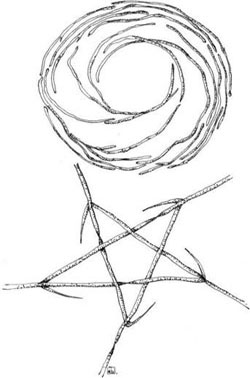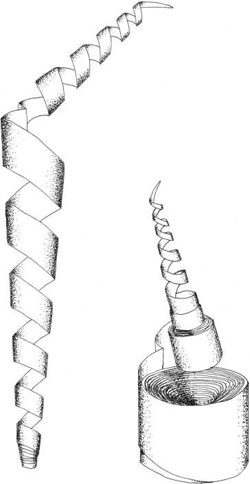Ejectile Organelles and Feeding Apparata
Heterokontophyta
Many species of Raphidophyceae have extrusome organelles that explode on strong stimulation throwing out up to 200 µm long slime threads. The material produced may surround a motile individual with mucilage so that it becomes palmelloid.
Haptophyta

FIGURE 2.82 Ejectile organelles of Phaeocystis sp. Coiled filaments before release (top); star-like configuration after release (bottom).
During its motile stage, Phaeocystis can eject ribbon-like filaments a few tens of nanometers wide and several tens of micrometers long. Their interconnections form a five-branch star-like configuration (Figure 2.82). The winding of the filaments inside vesicles, as well as their axial twist, are probably the consequences of their biosynthesis within a confined space. As a result, the filaments behave like spring-coils whose stored energy is released once the vesicles are broken and the filaments ejected. Using electron diffraction techniques, the filaments have been unambiguously characterized as being made of α-chitin crystals, the polymer chain axis lying along the filament direction. These chains are arranged antiparallel (allomorph) and this arrangement has never been reported before in the algal world.

FIGURE 2.82 Ejectile organelles of Phaeocystis sp. Coiled filaments before release (top); star-like configuration after release (bottom).
Cryptophyta

FIGURE 2.83 Ejectile organelles of a cryptophyte. Discharging ejectosome (left) and reel of an undischarged ejectosome just begining to be pulled out (right).
These algae possess large refractile ejectosomes, lining the oral groove, and small ejectosomes scattered around the cell surface at the anterior corners of the periplast plates. An undischarged ejectosome is a tightly coiled, tapered ribbon that is wound with the wider end towards the outside; a smaller coil is attached to it and lies in the depression of the larger one. Prior to release, ejectosomes are enclosed within vesicles. The large ejectosomes are explosive organelles. If cryptophyte cells are irritated by mechanical or chemical stress, they escape the potentially lethal influences by discharging the ejectosomes: the cells jump backwards in fast zig-zag movements through the water. When discharged, the ribbon unfurls, with the shorter segment forming a beaklike tip on the longer. The edges of the ribbon tend to curl inwards, producing circular and e-shaped profiles in cross-section (Figure 2.83).




